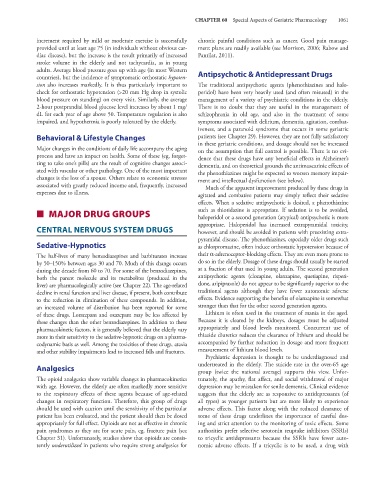Page 1075 - Basic _ Clinical Pharmacology ( PDFDrive )
P. 1075
CHAPTER 60 Special Aspects of Geriatric Pharmacology 1061
increment required by mild or moderate exercise is successfully chronic painful conditions such as cancer. Good pain manage-
provided until at least age 75 (in individuals without obvious car- ment plans are readily available (see Morrison, 2006; Rabow and
diac disease), but the increase is the result primarily of increased Pantilat, 2011).
stroke volume in the elderly and not tachycardia, as in young
adults. Average blood pressure goes up with age (in most Western
countries), but the incidence of symptomatic orthostatic hypoten- Antipsychotic & Antidepressant Drugs
sion also increases markedly. It is thus particularly important to The traditional antipsychotic agents (phenothiazines and halo-
check for orthostatic hypotension (>20 mm Hg drop in systolic peridol) have been very heavily used (and often misused) in the
blood pressure on standing) on every visit. Similarly, the average management of a variety of psychiatric conditions in the elderly.
2-hour postprandial blood glucose level increases by about 1 mg/ There is no doubt that they are useful in the management of
dL for each year of age above 50. Temperature regulation is also schizophrenia in old age, and also in the treatment of some
impaired, and hypothermia is poorly tolerated by the elderly. symptoms associated with delirium, dementia, agitation, combat-
iveness, and a paranoid syndrome that occurs in some geriatric
Behavioral & Lifestyle Changes patients (see Chapter 29). However, they are not fully satisfactory
in these geriatric conditions, and dosage should not be increased
Major changes in the conditions of daily life accompany the aging on the assumption that full control is possible. There is no evi-
process and have an impact on health. Some of these (eg, forget- dence that these drugs have any beneficial effects in Alzheimer’s
ting to take one’s pills) are the result of cognitive changes associ- dementia, and on theoretical grounds the antimuscarinic effects of
ated with vascular or other pathology. One of the most important the phenothiazines might be expected to worsen memory impair-
changes is the loss of a spouse. Others relate to economic stresses ment and intellectual dysfunction (see below).
associated with greatly reduced income and, frequently, increased Much of the apparent improvement produced by these drugs in
expenses due to illness. agitated and combative patients may simply reflect their sedative
effects. When a sedative antipsychotic is desired, a phenothiazine
■ MAJOR DRUG GROUPS such as thioridazine is appropriate. If sedation is to be avoided,
haloperidol or a second generation (atypical) antipsychotic is more
appropriate. Haloperidol has increased extrapyramidal toxicity,
CENTRAL NERVOUS SYSTEM DRUGS however, and should be avoided in patients with preexisting extra-
pyramidal disease. The phenothiazines, especially older drugs such
Sedative-Hypnotics as chlorpromazine, often induce orthostatic hypotension because of
The half-lives of many benzodiazepines and barbiturates increase their α-adrenoceptor-blocking effects. They are even more prone to
by 50–150% between ages 30 and 70. Much of this change occurs do so in the elderly. Dosage of these drugs should usually be started
during the decade from 60 to 70. For some of the benzodiazepines, at a fraction of that used in young adults. The second generation
both the parent molecule and its metabolites (produced in the antipsychotic agents (clozapine, olanzapine, quetiapine, risperi-
liver) are pharmacologically active (see Chapter 22). The age-related done, aripiprazole) do not appear to be significantly superior to the
decline in renal function and liver disease, if present, both contribute traditional agents although they have fewer autonomic adverse
to the reduction in elimination of these compounds. In addition, effects. Evidence supporting the benefits of olanzapine is somewhat
an increased volume of distribution has been reported for some stronger than that for the other second generation agents.
of these drugs. Lorazepam and oxazepam may be less affected by Lithium is often used in the treatment of mania in the aged.
these changes than the other benzodiazepines. In addition to these Because it is cleared by the kidneys, dosages must be adjusted
pharmacokinetic factors, it is generally believed that the elderly vary appropriately and blood levels monitored. Concurrent use of
more in their sensitivity to the sedative-hypnotic drugs on a pharma- thiazide diuretics reduces the clearance of lithium and should be
codynamic basis as well. Among the toxicities of these drugs, ataxia accompanied by further reduction in dosage and more frequent
and other stability impairments lead to increased falls and fractures. measurement of lithium blood levels.
Psychiatric depression is thought to be underdiagnosed and
Analgesics undertreated in the elderly. The suicide rate in the over-65 age
group (twice the national average) supports this view. Unfor-
The opioid analgesics show variable changes in pharmacokinetics tunately, the apathy, flat affect, and social withdrawal of major
with age. However, the elderly are often markedly more sensitive depression may be mistaken for senile dementia. Clinical evidence
to the respiratory effects of these agents because of age-related suggests that the elderly are as responsive to antidepressants (of
changes in respiratory function. Therefore, this group of drugs all types) as younger patients but are more likely to experience
should be used with caution until the sensitivity of the particular adverse effects. This factor along with the reduced clearance of
patient has been evaluated, and the patient should then be dosed some of these drugs underlines the importance of careful dos-
appropriately for full effect. Opioids are not as effective in chronic ing and strict attention to the monitoring of toxic effects. Some
pain syndromes as they are for acute pain, eg, fracture pain (see authorities prefer selective serotonin reuptake inhibitors (SSRIs)
Chapter 31). Unfortunately, studies show that opioids are consis- to tricyclic antidepressants because the SSRIs have fewer auto-
tently underutilized in patients who require strong analgesics for nomic adverse effects. If a tricyclic is to be used, a drug with

